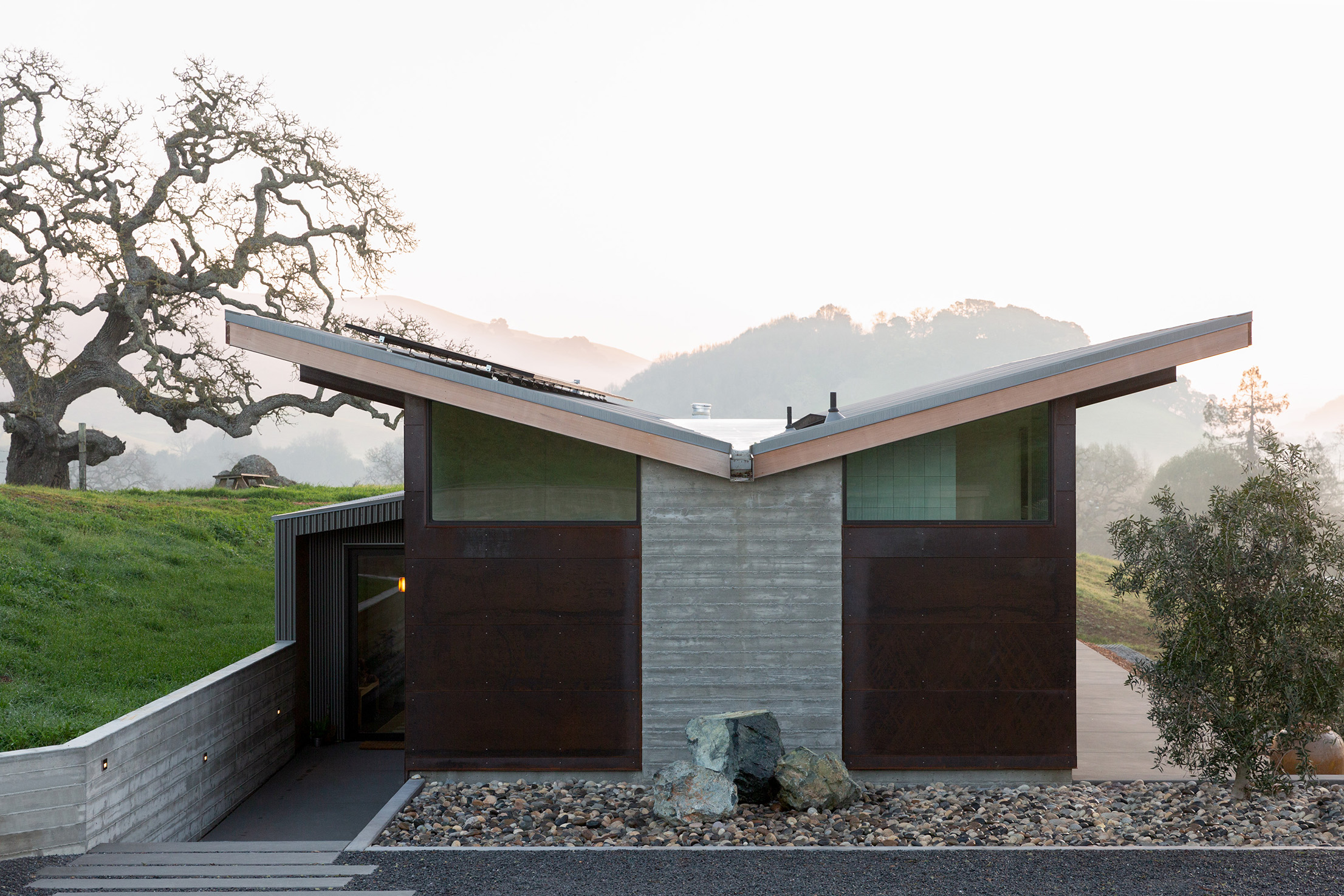Merit Award //project details Architect: MAD Architecture/ Mary Dooley, AIA Project Location: Petaluma/CA/US Photographer: Molly Haas Planted into a grassy bowl lived an old bay tree rooted in a large
The post Owl House appeared first on AIA California.
Owl House
//project details
Architect: MAD Architecture/ Mary Dooley, AIA
Project Location: Petaluma/CA/US
Photographer: Molly Haas
Planted into a grassy bowl lived an old bay tree rooted in a large rock outcropping, and a grove of blue oak. A driving coastal wind and noise pattern came in from the west. The land told the new house, “We all grow from the grasslands.” So the new house nested among the inhabitants, hunkering into the bowl’s shelter.
The site design tracks the sun, blow-out views, and the natural contours allowing the watershed to serve the bowl as before. Remnants of the historic Olompali Rancheria fence line form the east wall boundary angled to align. The roof form lands in mid-flutter of a butterfly serving the desire for big views while hiding photovoltaics.
Under the butterfly roof are the living, kitchen, dining and only bedroom supported by steel moment frames at 12-foot intervals– the most efficient span for SIPS roof panels preventing waste. The kitchen is central, giving the dining area the prime space to watch golden hour. Like a shed clinging to a barn, the 1/2 bath, office, pantry, laundry and mechanical rooms hold back the hillside. The house is all electric. Fire resilient exterior is concrete end walls, Corten siding, metal roofing and rated cedar eaves.
//comments
This project does all the right things with a nice small footprint; it’s really strong. | The structural approach is uplifting.
//framework for design excellence measures
Measure 1: Design for Integration
The design approach starts with architects researching the history of the land and the design team including the clients experiencing the seasons. The idea was to bring livability passively, formally, and nestled. Questions: Where to get evening views in the golden hour? The best place to have a coffee? Can the winged roof mimic an owl’s face, soar upward expanding connections to the native birds? The team attempted to answer as if setting up a campout shelter. The foyer frames the living space and a jawdropper – expansive views downslope and up again taking in oak woodlands far and wide. The house does not cross the Olompali line, but is aligned with it, creating an angled slice at the edge of the house. While the house rests in the bowl, the history and the wildlife corridors remain. Sunshading the glass in high sun under 6-foot eaves, the sunlight reaches in during the cold months. The team pushed for all electric, installing Photovoltaic panels on the upflap of the butterfly roof. The house achieves a -8.2 Energy Use Index, which was assisted by careful site planning, thermal mass using broad window expanses. The house produces 140% of its energy.
Measure 2: Design for Equitable Communities
Our clients picked their property location with the intention to form a community with their close by friend. Since then they have connected with many other farmers and ranchers. Their community is all about sharing, e.g. they share rides, or they share food, since one has an orchard and another one has eggs. Our clients will also start a farm stand at the local school that is 5 minutes away.
Measure 3: Design for Ecosystems
Other than an orchard for growing food, no non-native plants were introduced other than an Olive Tree at the entrance requiring low water. The habitat is improving with the goats grazing reudcin gthe invasive thistles that over power the native Timothy grassesbeneath the oaks. Firtted glass and exterior shutters were proposed for bird protection, but the owner chose to first try window shades. It has helped, but a window film on the exteiror is likely forthcoming.
Measure 4: Design for Water
The house returns the water to the land via the large scuppers on each end of the butterfly roof. There is no irrigation besides the orchard because there is no planting other than the succulents around the patio and the olive tree. The house uses water for radiant heat in a closed loop. There is a well that serves the small community of residents and is pumped to the tanks and gravity fed to the homes. Graywater will be added in the future as the new owners settle in.
Measure 5: Design for Economy
The project had to address the fixed income of the retired couple and reduce long term maintenance and yearly operating costs. Hence, an all electric house run on the sun, multi use flexible spaces and a minimal pallette of materials. The exterior palette is to Corten, Cedar, Concrete and Glass. The interior is gypsum board and douglas fir, and concrete. Intent was simplicity with a little bling – ie the metal trellis and the Heath tile.
Measure 6: Design for Energy
The envelope has been designed to leverage passive heating and cooling strategies. Glazing on the north is minimized, glazing on the south is maximized. The summer sun is kept out through large overhangs, that allow passive heating during winter days. Through a clever window set up night flushing eliminates the need for active cooling. A 8.6 kW photovoltaic system provides over 100% of the houses energy needs. 16% of the house’s energy consumption is covered through two on-site batteries (a total of 27kWh), helping to reduce loads on the energy grid during peak evening hours.
Measure 7: Design for Well-Being
Natural light, views and plenty of ventilation connection the residents to the nature that is all around this house. To avoid excessive heat gain, the deep eaves provide shade for the warmer days of the year. There were no toxic chemicals used. Every chemical met California standards for zero VOC.
Measure 8: Design for Resources
In a wildfire risk area, steel is an obvious choice for constructing a building that can endure. The fact that steel comes with a high carbon footprint is counterbalanced by its longevity and end-of-life options: Steel framing, siding and roofing (as well as SIP panels and windows) can be disassembled and used in a new building. Fly ash was used in the concrete to reduce Portland cement. Local douglas fir source for all the cabinetry. The builder contributed to a re-forestation company to offset the trees used in the wall framing. Local tile manufacturer.
Measure 9: Design for Change
Fire Resiliency was the envelope requirement in the wildland zone. The site has room for an addition to accommodate more spaces. The septic system was built to accommodate two additional bedrooms. The one-story house can easily be modified into a Universal Design home. There are two Tesla batteries for stored electrical power and the water tanks are gravity fed. The passive solar heating and cooling with operable shades maintain a reasonable level of comfort without employing the radiant heating in the floor.
Measure 10: Design for Discovery
SIPs and butterflies were new for the builder, but they were inspired by the design and precision required which became a matter of great pride for every trade involved. When the concrete slab forms were prepared we made changes to enlarge the east patio and increase the retaining wall. The sloping site was challenging for the delivery and storing of SIPs prior to installation which was delayed due to rain. SIPs work better with a large flat area for delivery. The owners are discovering where there favorite places are in different seasons.
The post Owl House appeared first on AIA California.
AIA CaliforniaRead More





